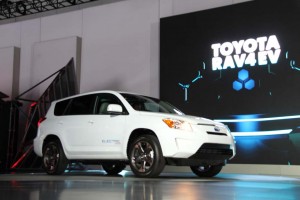
Battery power could be essential if the EPA ultimately sticks to its 62 mpg target. Shown here the 2012 Toyota RAV4-EV.
Federal regulators will push back by nearly a year proposed fuel economy standards that could eventually require automakers to deliver as much as 62 miles per gallon on a fleet-wide basis.
The ongoing debate over the proposals has only been heating up now that any proposal to increase mileage would have to go before a House committee soon to be controlled by the new Republican majority.
The Obama Administration has already indicated its tentative support for raising mileage mandates significantly once the current 35 mpg standard is met in 2016. With the White House looking at annual increases of 3% to 6%, that could mean a 62 mpg target for 2025.
While industry leaders ultimately rallied around the 2016 standard, there is still significant resistance to pushing much higher, with skeptics citing both costs and technical limitations. The Administration had projected that reaching 62 mpg would add as much as $3,500 to the price tag of the typical vehicle sold in the U.S. market.
But the Environmental Protection Agency, which is spearheading the study, has argued that consumers would more than be able to recover the added costs, with fuel savings estimated to run as much $7,400 during the typical ownership cycle.
The agency issued a 35-page report, Tuesday night, outlining the issues still under debate and setting out a goal of having the study wrapped up by September 2011. EPA officials still hope to finalize future rules by July 2012. That could make the issue of automotive fuel economy a topic of much debate during the run-up to the next presidential election.
The political wrangling has already intensified, notably so since last month’s election, which will shift power in the House of Representatives, come January. Several of the names being bandied about as possible House Energy Committee chairman are openly skeptical of matters such as global warming – and appear to be more willing to listen to industry complaints about the cost of boosting fuel economy.
Among other things, a 62 mpg standard would be likely to require a significant shift in vehicle design, including not only downsizing but the use of more lightweight materials, such as aluminum and composites. But there are safety implications to such changes that both the EPA and the National Highway Traffic Safety Administration still must address.
Industry leaders, such as Hyundai’s U.S. chief executive, John Krafcik, have also indicated that they would expect to make a significantly more aggressive push into electric propulsion, which many believe would be the only way to make it to 62 mpg.
Considering the long R&D and product development cycles within the industry, automakers are beginning to move on the assumption of a sharp mileage increase, even if the ultimate number fall short of 62. That’s one of the reasons why General Motors, earlier this week, announced plans to add another 1,000 jobs withing its battery-car development program.
